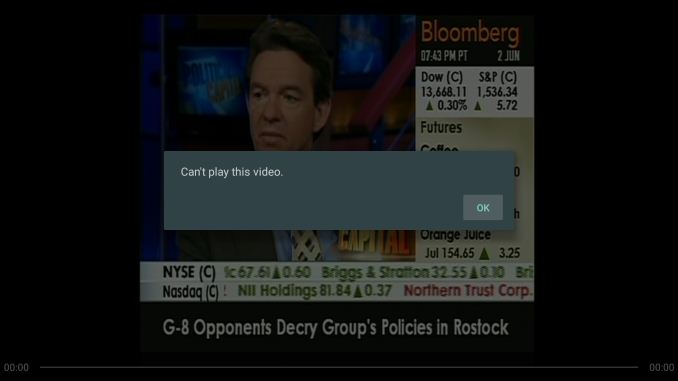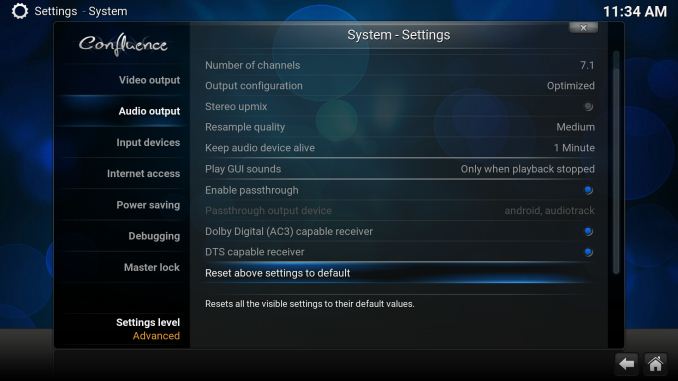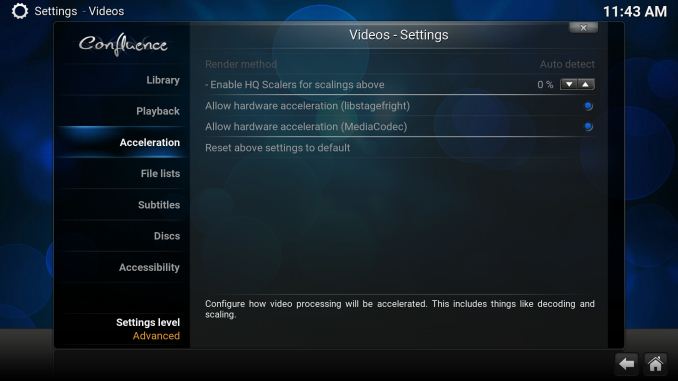The NVIDIA SHIELD Android TV Review: A Premium 4K Set Top Box
by Ganesh T S on May 28, 2015 3:00 PM EST- Posted in
- Media Streamer
- Home Theater
- TV
- 4K
- Shield
- NVIDIA
Local Media Playback Evaluation
The announcement of the SHIELD Android TV box generated a lot of interest amongst media streaming enthusiasts. It has continued to this date. Given that most of them prefer local media playback to OTT streaming, there has been marked interest in the local media playback capabilities of the unit. In this section, we attempt to set the expectations right on the various relevant aspects.
Display Refresh Rate
The Android TV framework forces the interface and most apps to run at 60 Hz. Obviously, a 24 fps film needs to be pulled-down with a 3:2 cadence to let the display be refreshed at 60 Hz. This creates a judder effect. Apps such as TVHZ were created to resolve this issue, but needs manual intervention prior to media playback. Kodi's currently existing 'sync refresh rate to playback frame rate' option doesn't work, but a fix is probably coming soon.
Codecs Licensing
Unlike a PC, the SHIELD Android TV is an embedded system. Therefore, codec support involves NVIDIA signing licensing deals. For example, support for Dolby Digital / Dolby Digital Plus requires deals with Dolby Laboratories, while DTS / DTS-HD support requires deals with DTS. On the video side, H.264 support, for example, requires a deal with MPEG-LA. Each of these deals ends up increasing the end cost for the consumer. In order to hit an acceptable price point while ensuring all necessary components for OTT streaming (SHIELD's primary market) are in place, NVIDIA has signed deals for the following audio/video codecs only:
- H.264
- H.265
- VP9
- Dolby Digital (Update: only bitstreaming, no internal decode to PCM)
- Dolby Digital Plus (Update: only bitstreaming, no internal decode to PCM)
This means that the native Android Video Player can only play back the above codecs (in addition to the free-to-decode / play ones such as PCM audio). This also means that the SHIELD Android TV will not be doing any HD audio bitstreaming in the near future unless things chance on the licensing front.
That said, players such as Kodi, MX Player etc. can opt to use pure software decoding when hardware decoding is not available. It is also possible for app vendors to purchase the license themselves and then work with NVIDIA to get hardware acceleration / support for that. For example, SiliconDust (the vendor behind HDHomeRun) is doing it with their Live TV app in order to get hardware decoding enabled for MPEG-2.
Attempting 480i60 MPEG-2 Playback with the Native Android Video Player
Video Post Processing
Deinterlacing and pull-down detection / IVTC are essential for watching certain live TV channels and other interlaced content. NVIDIA only guarantees video post processing for the licensed codecs that go through their hardwrae decoder. Third-party players will need to work with NVIDIA to ensure that any software decoded streams are correctly hooked up to the post-processing chain.
We tried processing the HQV Benchmark videos on the SHIELD to get an objective evaluation of the SHIELD's post-processing capabilities, but unfortunately the MPEG-2 encoded streams were not processed properly when decoded in software on Kodi.
Experimenting with Kodi
The Kodi 15.0 beta 1 APK is available for sideloading on to the SHIELD Android TV. On the bitstreaming side, we could only select DTS and Dolby Digital, and Kodi had no problems bitstreaming those streams.
We played back our test streams from a Samsung T1 portable SSD attached to the USB 3.0 port. HEVC streams played back with hardware acceleration inside the Kodi interface, but Kodi had trouble with TS files. For hardware-accelerated codecs, the power consumption at the wall was around 6 W. For software-decoded ones such as our 1080i60 VC-1 clip, the power consumption shot up to 11.5 W.
The SHIELD Android TV / Kodi combination has absolutely no trouble with the vanilla H.264 files that people usually rip their Blu-rays to. Fortunately, despite the lack of MPEG-2 and VC-1 licenses, Kodi's software decode is efficient enough to not cause frame drops. The absence of deinterlacing is an issue, but that should hopefully get resolved soon.
Based on our evaluation, the SHIELD Android TV is definitely not a comprehensive HTPC replacement - particularly from the local media playback viewpoint. That said, it does have support for all major OTT services and Live TV as well as future DVR capabilities (thanks to Android TV). For a certain set of users, it is possible that the SHIELD can replace their HTPC. However, one needs to remember that the unit is an embedded system with plenty of constraints and doesn't have the same openness and flexibility that a HTPC has to offer.













167 Comments
View All Comments
ganeshts - Thursday, May 28, 2015 - link
From NV: "we do not have an empty HDD bay in the 16GB sku. Users will not be able to add their own HDD into the 16GB sku."ZOONAMI - Friday, May 29, 2015 - link
Wow thank you for prompt reply!Cami Hongell - Thursday, May 28, 2015 - link
Tellybean is the first video call service on Android TV and the SHIELD is the first device that works with a regular Logitech camera. Try it out and please let us know what you think. http://eepurl.com/blSzU9vdek - Thursday, May 28, 2015 - link
How does the performance compare to the XB1 and PS4? Those would seem to be the two immediate competitors for this device. It seems like Anandtech has grown too focused on comparing everything to Tablets/phones...kron123456789 - Thursday, May 28, 2015 - link
"How does the performance compare to the XB1 and PS4?" — It doesn't. This is just hardware:Sheild Android TV — 256 CUDA cores(at ~1GHz), 16ROPs, 16TMUs, 3GB of RAM with 25.6GB/sec bandwidth
Xbox One — 768 GCN cores(at 853MHz), 16ROPs, 48TMUs, 8GB of RAM with 68.2GB/sec bandwidth
PS4 — 1152 GCN cores(at 800MHz), 32ROPs, 72TMUs, 8GB of RAM with 176GB/sec bandwidth
ppi - Thursday, May 28, 2015 - link
Given that basically all TVs now are "smart", what are real advantages of device such as this one over a Smart TV? I am talking video and content playback, of course.While I do not own 4K TV, my 1080p Samsung has no trouble playing HD YouTube and variety of formats from USB disk.
jt122333221 - Thursday, May 28, 2015 - link
More content should be available on Android TV, and it's more likely to be updated than your TVs. Also, there are a lot of people who don't have a Smart TV and who would prefer NOT using their TV's smart features (I despise mine, the interface is horrible, apps are abysmal; only reason I have it is because it came with the TV I wanted).Yojimbo - Thursday, May 28, 2015 - link
I have a Samsung smart tv and it's slow, slow, slow.jeffkibuule - Thursday, May 28, 2015 - link
When's the last time your TV got a meaningful software update?TheJian - Friday, May 29, 2015 - link
You did see the gaming benchmarks right? If that wasn't a major point for the user, not sure why you would pay for this here other than playing all kinds of formats from your USB drives (flash etc), across the network (smart tv's usually not good at that either). Not to mention Grid gaming, which eliminates much of the need for a high end PC and constantly buying $60 games (be it console or PC).You have to be looking at this for more than just vids I think. IE you can do anything android devices can do. Meaning play their games, browse the web etc. I can sit on the couch and browse with a keyboard and mouse with this and a big screen (saving me a fat foot after 8hrs at work and some home time also on top). Too bad anandtech didn't bother to use it like this and comment.
I think SMART tv's are actually pretty stupid. They basically can stream some crap from netflix, youtube, amazon etc and not much more. Now if your tv has roku built-in or something, ok maybe sort of smarter but even that lacks major formats (really just has far more channels than smart tv's). My roku 2/3's are useless for USB sticks on about 80% of my content. I end up sticking it in the bluray player instead as most of the time it either can't play the audio or can't play the video.
If all you're after is movies and some streaming, I'd probably rather have a bluray player for $79-$99 that plays almost all formats from USB and streams fine, not to mention playing all disc formats (LG, BP350 $79 or something). Or even just a roku2 (new model with faster chip or roku 3 if using headphones in remote is needed) if just after streaming stuff but again, from usb sucks here, so I'm just talking web streaming vids.